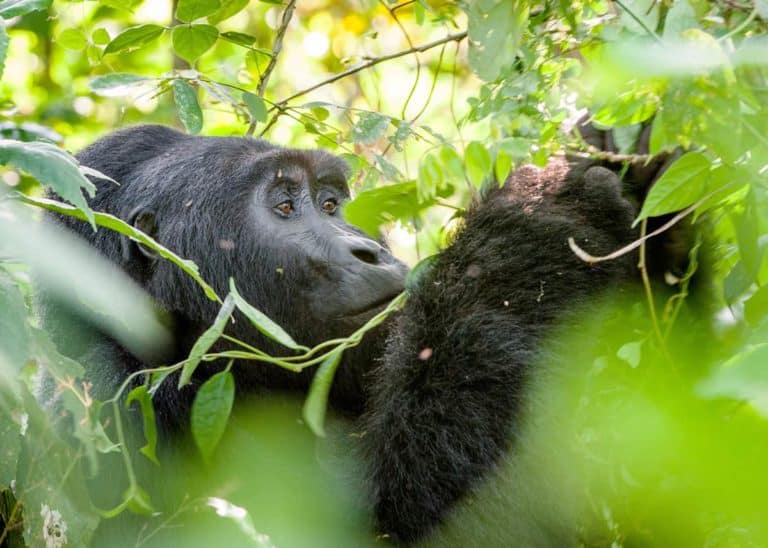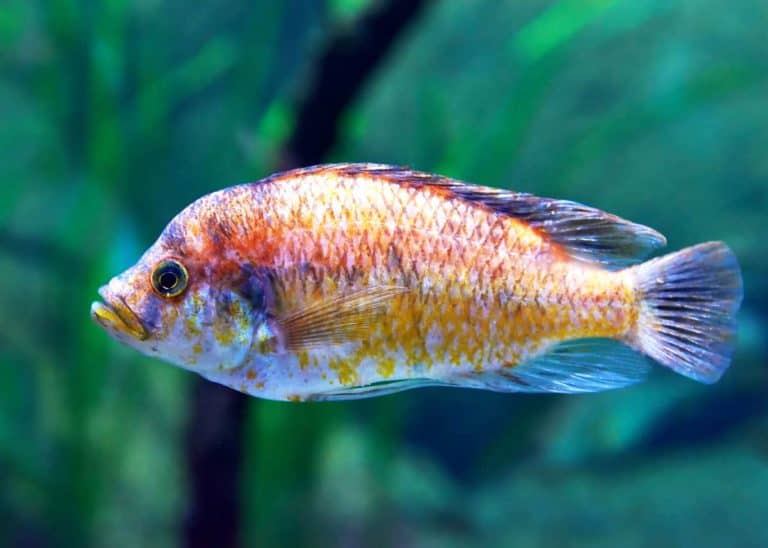What Do Kangaroos Eat? All Species (Likes, Plants, Meat?)
What do kangaroos eat? The short answer is grass (like a cow). The longer answer depends on the kangaroo and where it lives. Ground-dwelling kangaroos are herbivores, meaning they only eat plants and vegetables. There are four kangaroo species and they each have slightly different diets. Keep reading to learn more about these beloved Australia natives.
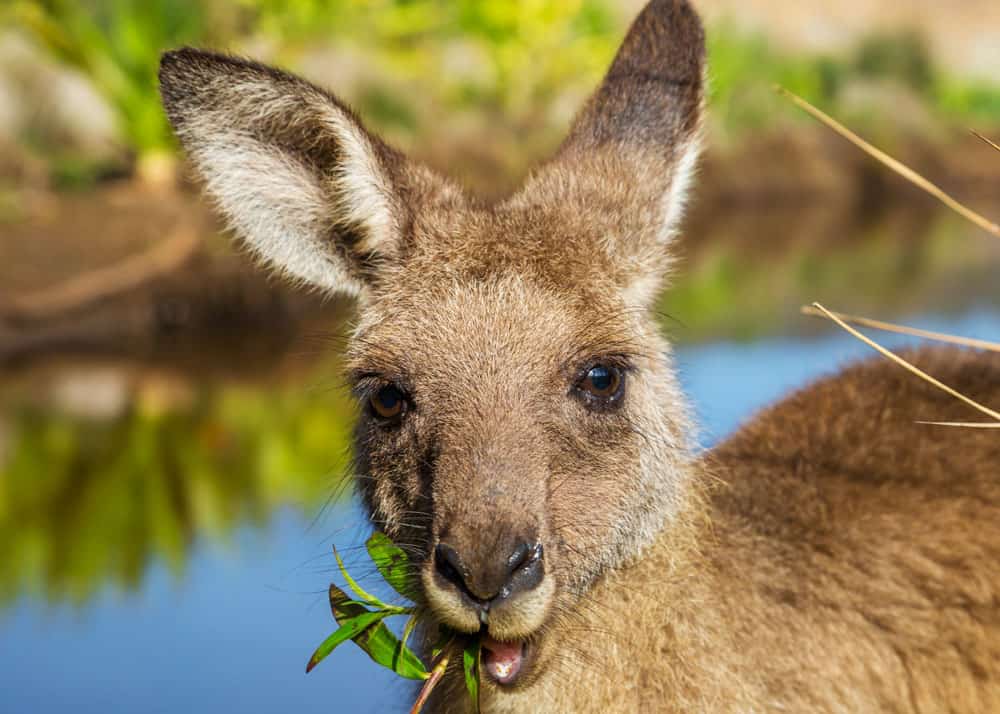
Guide to Kangaroo Diet: All Species
What is a kangaroo’s diet? In this guide, you’ll find specific diets for each of the four ground kangaroo species. Plus, we cover a number of common kangaroo diet questions at the end of the post.
In this guide, we cover the following four kangaroo species:
- Red kangaroos
- Eastern grey kangaroos
- Western grey kangaroos
- Antilopine kangaroos
Okay, lets get started!
1. What do red kangaroos eat?
- Common name: Red kangaroo (Osphranter rufus / Macropus rufus)
- Kangaroo eating habits: Grazes on grasses and some flowering plants and shrubs
- Also known as: Red giant kangaroo
- Range: Arid and semi-arid parts of central and western Australia
- Size: Height: 6 feet (1.8 m); Weight: Up to 200 pounds (90 kg)
- Unique feature: World’s largest marsupial and can go months without water
Not only is the red kangaroo the largest of all the kangaroo species, but it’s also the largest marsupial in the world. A male red kangaroo can grow up to nearly 7 feet (2 m) in height and up to 200 pounds (90 kg).
This species is named red kangaroo because of the male’s short red fur but is also called the giant red kangaroo because of its large size. This kangaroo is sexually dimorphic as the female is much smaller and wears a blue-gray fur coat in contrast to the male’s red coat. Both sexes feature long, raised ears and a rectangular face with black and white markings on each side of the muzzle.
Red kangaroos are found grazing on grasses and some shrubs across Australia’s central mainland. They have adapted to their dry, arid habitat so that the moisture from their food enables them to go months without drinking water.
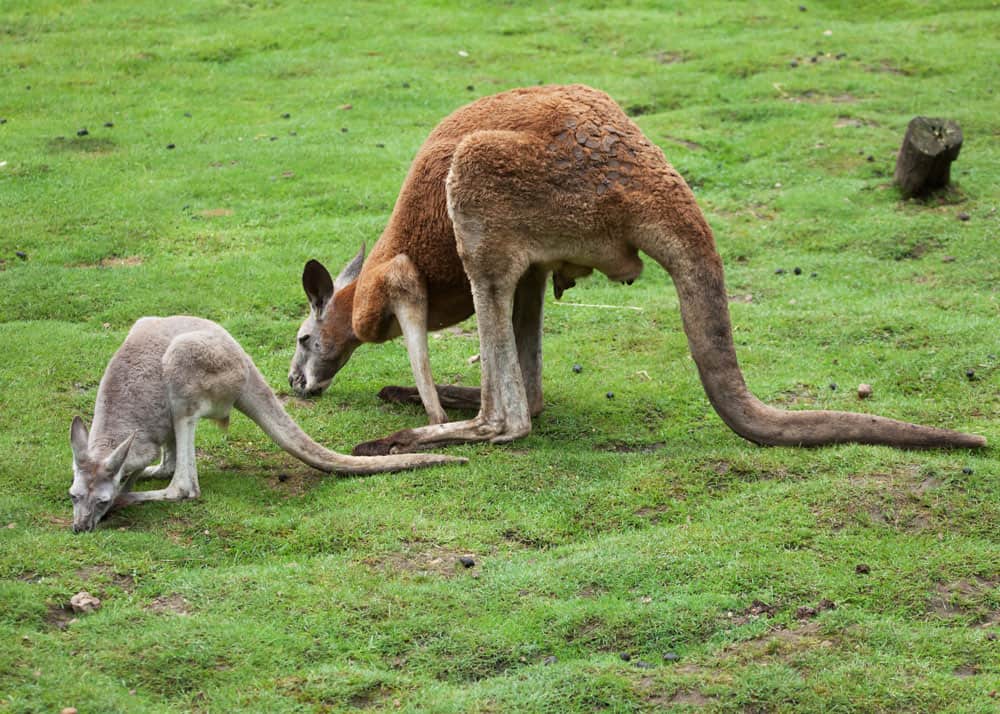
If you want to capture these in the wild, you’ll want a decent camera. Here’s our guide to choosing the best travel camera.
2. What do eastern grey kangaroos eat?
- Common name: Eastern grey kangaroo (Macropus giganteus)
- Kangaroo eating habits: Variety of grasses
- Also known as: Forester kangaroo, Great grey kangaroo
- Range: Fertile regions of eastern Australian mainland and Tasmania
- Size: Height: 6.6 feet (2 m), Weight: Up to 146 pounds (66 kg)
- Unique feature: Most populated kangaroo species
It’s a common misunderstanding that the well-known red kangaroos are the most populated kangaroo species. However, it’s the grey kangaroo species that holds that title.
If you want to see eastern grey kangaroos, you’ll need to visit the eastern region of Australia’s mainland from the Cape York Peninsula down to Victoria. If you go to Tasmania, you might possibly see them as they’re the only kangaroo species living there in the wild.
From a glance, you might easily confuse an eastern grey kangaroo with a western grey kangaroo, but an eastern species is larger and has a more grayish outer coat and cream or silver belly. Although it’s smaller than the red kangaroo, the eastern grey has a stockier and more muscular build with a long, powerful tail. An eastern grey doesn’t feature the markings around the muzzle like the red kangaroo but has larger, wider eyes.
Like other species, eastern grey kangaroos usually feed during twilight times of morning and night. They eat a variety of grasses in open grasslands and rest in the shade of trees during the day.
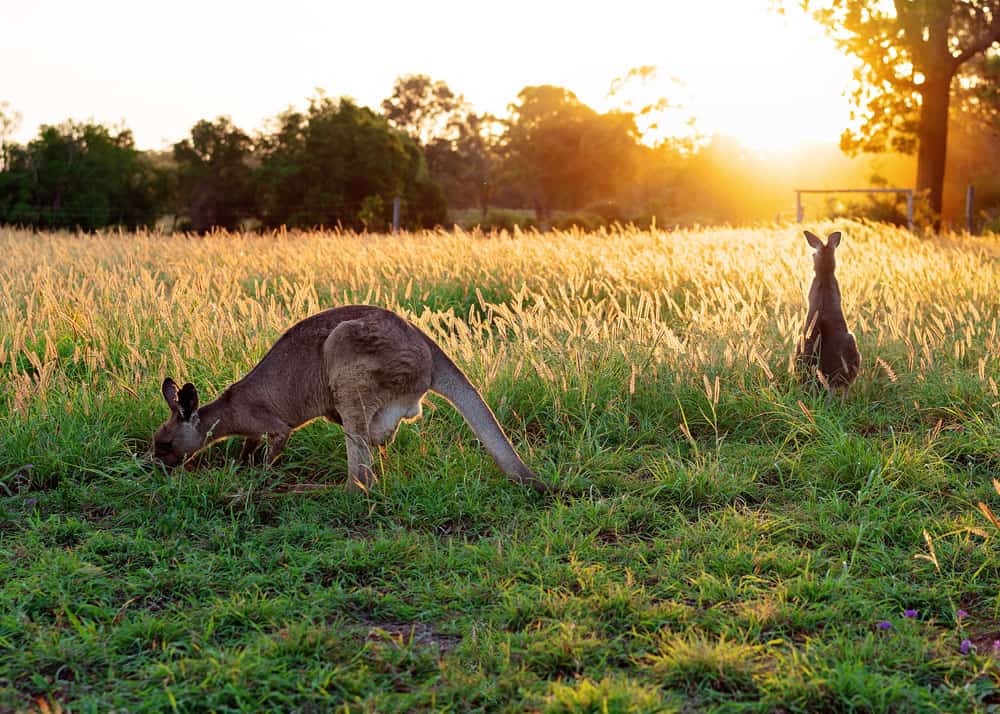
3. What do western grey kangaroos eat?
- Common name: Western grey kangaroo (Macropus fuliginosus)
- Kangaroo eating habits: Grazes at night mostly on grasses but also feeds on low trees and leafy shrubs
- Also known as: Sooty kangaroo, western grey giant kangaroo, mallee kangaroo, and black-faced kangaroo
- Range: Southern and southwestern Australia
- Size: Height: 4.3 feet (1.3 m); Weight: 119 pounds (54 kg)
- Unique feature: Males produce a distinctive odor that’s compared to curry
If you’re in Western or South Australia, the kangaroos you’re most likely to see are the western grey species. Found in larger populations near the western regions of the Nullarbor Plain of Western Australia and the Riverina region of New South Wales, the western grey can also be seen in the Murray-Darling basin where their range overlaps with their eastern grey cousins. However, the two species rarely ever breed successfully in the wild.
The western grey kangaroo is the smallest species and is distinguished from the eastern kangaroo by its smaller size and darker greyish-brown fur. The western species also features darker coloration around the head which is why it’s sometimes called the black-faced or sooty kangaroo. This roo is also pegged with the nickname “stinker” because the male produces an odor that’s compared to that of curry.
The western grey kangaroos feed at nightfall and early morning mostly on grasses but also low tree leaves and leafy shrubs.
If you’re out watching kangaroos all day, you need sun protection. Here are our picks for the best sun protection hats.
4. What do antilopine kangaroos eat?
- Common name: Antilopine kangaroo (Osphranter antilopinus)
- Kangaroo eating habits: Grazes on short, green grasses
- Also known as: Antilopine wallaroo, antilopine wallaby
- Range: North Australia
- Size: Height: 4 feet (1.2 m); Weight: Up to 108 pounds (49 kg)
- Unique feature: Its fur is similar to antelopes
In the grasslands, forests and plains of the far northern region of Australia, you’ll find mobs of antilopine kangaroos. These social creatures get their name from their fur that is similar in both texture and color to that of antelopes.
Also called the antilopine wallaroo and antilopine wallaby, this small roo features a habitat and behavior that’s more in common with the red and grey species. Physical traits that distinguish the antilopine from other kangaroos include its smaller size, reddish-tan fur, dark paws, and black snout tip. Female antilopines are more grey than their reddish-tan mates.
Antilopine kangaroos are grazers like the others on this list, but they’re known to eat short, green grasses as well as portions of long grasses that have been burned by bush-fires. They mostly feed during the morning and evening, but rainy seasons may cause them to eat during the day and night.
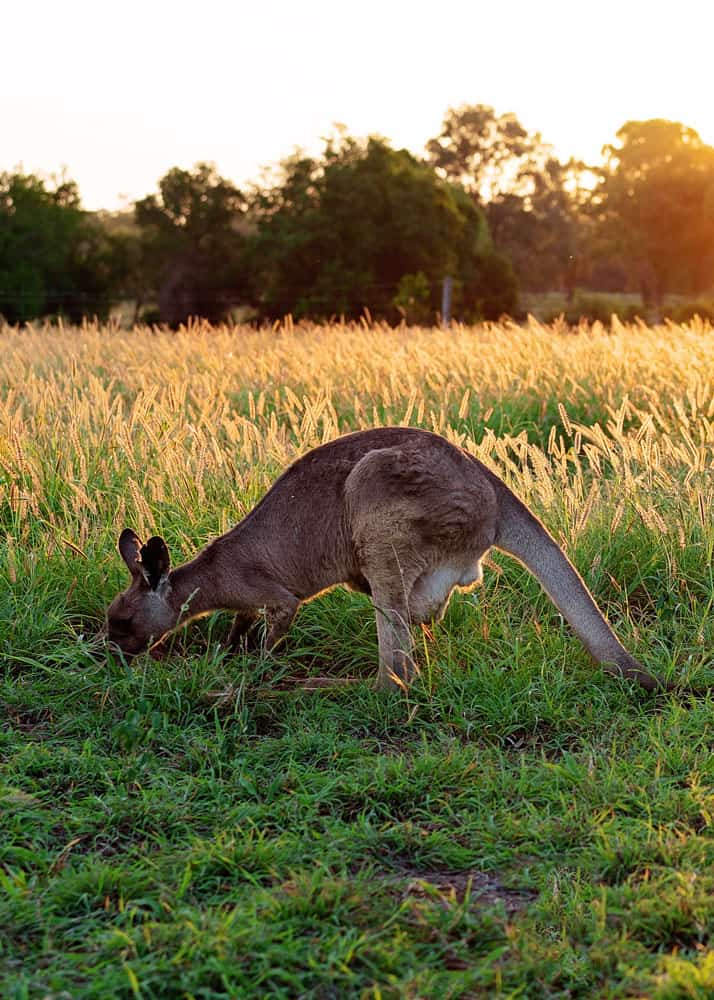
6 Kangaroo Diet Questions Answered
Okay, now with the specific diets covered, now lets move on to some common questions.
1. What do joeys eat?
A joey, or baby kangaroo, feeds on its mother’s milk inside her pouch for approximately nine months.
You may also find it interesting to learn that a mother kangaroo can suckle two joeys of different ages at the same time with milk containing different nutritional compositions to suit the development of each of these joeys.
2. Are kangaroos omnivores?
This depends upon the type of kangaroo. Ground-dwelling kangaroos, such as the four species listed in the post, are strict herbivores. Therefore, they eat only plants but never meat.
They are also considered folivores – a specific type of herbivore that specializes in a leaf diet.
Do kangaroos eat meat? Some tree kangaroos that are omnivores, eating both plants and meat. These types of kangaroos eat everything a tree produces (leaves, bark, fruit, flowers, sap and seeds) but also bird eggs, bird hatchlings and other small animals.
Ground-dwelling kangaroos don’t eat meat, but tree-dwelling kangaroos do.
3. Do kangaroos chew their cud?
Yes, ground kangaroos sometimes chew their cud like cattle and sheep. But different than cows and sheep, kangaroos only have a single chambered stomach (compared to their 4 compartments).
Chewing the cud refers to a regurgitation of the vegetation, chewing it again, then swallowing a final time for digestion. This isn’t as common in kangaroos as in actual ruminants.
4. Do kangaroos eat carrots?
Yes, kangaroos like the ones discussed in this post will eat carrots. In fact, they love gardens and are often considered pests in Australia because they help themselves to the free food.
5. What do pet kangaroos eat?
Kangaroos are rarely kept as pets, but they are held in captivity for conservative and rehabilitation reasons. Those living in captivity, including zoos, are usually fed pellets that are formulated with nutrients most suitable for their digestive systems.
They’re additionally fed alfalfa hay, dandelion leaves, and fruits and vegetables such as carrots, broccoli, lettuce, apples, bananas, and grapes.
6. Is it okay to feed kangaroos in the wild?
While it’s not uncommon to spot kangaroos nearby urban areas such as parks and golf courses, feeding these creatures in the wild is not recommended for the following reasons:
- Human food can cause nutritional imbalances, illnesses, and obesity which can make it difficult for kangaroos to evade predators such as dingoes.
- If many kangaroos regularly feed in a certain area, they’re more likely to ingest parasites from grass that’s contaminated with feces.
- Feeding mobs of kangaroos stirs up competition among individuals and could make them aggressive toward one another as well as humans. It could also make them vulnerable to humans who wish to do them harm.
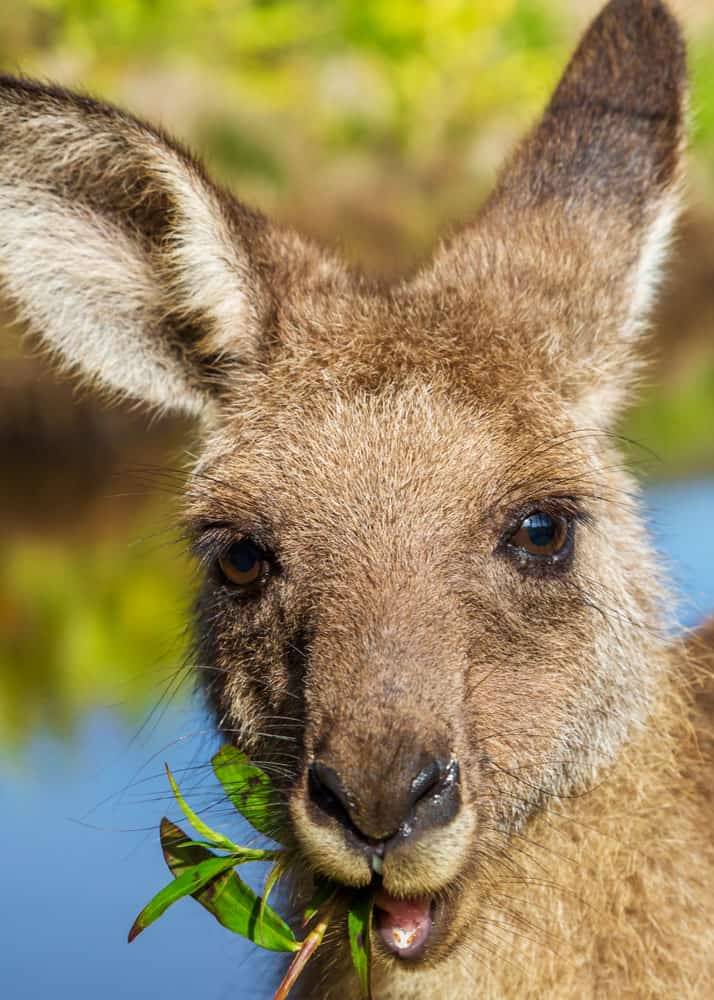
Keep reading: What Do Rhinos Eat? Guide to All 5 Species
Your Turn
And there you have it, the guide to the kangaroo diet. And specifically what kangaroos like to eat. Have you seen these in the wild? Have you seen them feeding? Have a tip or question? Let us know your thoughts in the comments!





